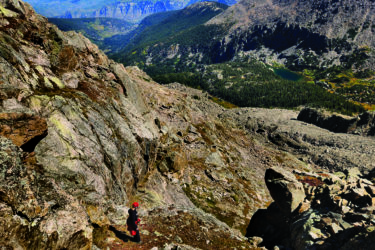The Local newsletter is your free, daily guide to life in Colorado. For locals, by locals.
If you’ve tackled a fourteener lately, it might feel like you shared the trail with all 5.84 million people that call this state home (and a few Texans, of course). But a new report from the Colorado Fourteeners Initiative (CFI), the nonprofit responsible for building most of the routes up these summits, reveals that things aren’t always what they seem.
In 2023, the number of people climbing Colorado’s 14,000-footers dropped to an all-time low: 260,000. That’s the lowest figure recorded since CFI began collecting data in 2015.
In some ways, this could be a natural balancing out following the pandemic-driven hiking boom in 2020. But Lloyd Athearn, CFI’s executive director, believes it could be indicative of larger demographic shifts in the Centennial State. “Colorado, historically, has been one of the fastest growing states in the nation, and since 2020, things have really tailed off,” Athearn says. “We’re not growing nearly as fast as we used to.”
Avid hikers will also remember that three of Colorado’s 58 fourteeners were off-limits for much of 2023. Landowner John Reiber closed the Decalibron Loop—which delivers hikers to the summits of Mts. Democrat, Cameron, and Lincoln—from March through the end of July due to liability concerns. In a typical year, these three peaks would be among the top five most hiked fourteeners.
But before you start panicking (or rejoicing) that everyone has forgotten your favorite fourteener, Athearn reminds us to put these numbers in perspective. “Maybe this just takes some pressure off of our mountains,” he says. “There’s still a considerable number of people out there, and there are infinitely more people out there, even in a slow year, compared to, say, 25 years ago.”
We sat down with Athearn to find out which 14,000-foot peaks are the most popular—and which are not.
Colorado’s 5 Most Popular Fourteeners
1. Mt. Bierstadt
- Elevation: 14,064 feet
- Hike distance (round-trip): 7.3 miles
- Number of hikers in 2023: 29,000
Back in 2017, Athearn joked that this Front Range fourteener needed an interstate to accommodate all the foot traffic—and that’s still true today, even as overall numbers drop. Last year, roughly 29,000 hikers climbed Mt. Bierstadt, making it the most popular fourteener in Colorado—most likely. Athearn cautions that only six days of hard data were tabulated on the mountain before someone with sticky fingers stole the thermal trail counter CFI uses to track traffic—for the second year in a row. That means most of the 2023 data for this particular peak was projected using CFI’s modeling system. But considering the climb up Bierstadt is one of the easiest and shortest ascents on the list, this number doesn’t seem all that far-fetched.
2. Quandary Peak

- Elevation: 14,269 feet
- Hike distance (round-trip): 6.75 miles
- Number of hikers in 2023: 27,000
New parking restrictions put in place at Quandary’s trailhead in 2021 drove down traffic for a few years, but it bounced back 23 percent in 2023—equating to 5,000 more hikers than in 2022. That means hikers aren’t exactly being deterred by a parking reservation that can cost up to $55. Why? The proximity to the Front Range and the easy drive from Breckenridge (no harrowing Forest Service roads) probably contribute. Mostly though, it’s just a straightforward, relatively easy climb: Trekkers gain a total of 3,450 feet over the course of 3.3 miles; the trail isn’t exposed; there’s little risk of rockfall; and you don’t need to be a whiz kid with a map and compass to find the summit. In other words, if there was a Fourteeners for Dummies book, Quandary would certainly be included.
3. Mt. Elbert
- Elevation: 14,437 feet
- Hike distance (round-trip): 9.75 miles
- Number of hikers in 2023: 22,000
Who doesn’t want to brag that they’ve bagged the tallest mountain in Colorado (and the second-tallest in the continental United States)? But the real draw of 14,437-foot Mt. Elbert, which lords over the Sawatch Range outside of Leadville, is that it doesn’t demand much sweat equity at all. The roughly five-mile hike to its apex ascends 4,500 feet, mostly on defined singletrack. It’s no cakewalk, to be sure, but it’s nearly impossible to get lost, there are several flat sections to catch your breath, and the path doesn’t skirt the edges of any heart-pumping cliffs. Plus, this peak’s reputation in the record books makes it a popular choice for out-of-state hikers looking for some trail cred.
4 and 5. Grays and Torreys Peaks
- Elevation: 14,275 feet (Grays); 14,270 feet (Torreys)
- Hike distance (round-trip): 8.25 miles
- Number of hikers in 2023: 21,000
We don’t have to tell you why this dynamic duo made the list. This two-for-one trek has all the agreeable attributes of the other three mountains—close proximity to Denver and a beginner-friendly route—but you get to pose for two Instagram photos instead of one. In fact, Grays and Torreys were the only Front Range fourteeners to see an increase in traffic last year. So for those who couldn’t bag three peaks in one day while the Decalibron Loop was closed, their next-best option was Grays and Torreys.
But these BOGO summits aren’t just for newbies. For a less congested route, more skilled climbers can tackle Kelso Ridge, a knife’s-edge spine with drop-offs on both sides that leads to the Torreys summit. The less popular way up is one of Athearn’s all-time favorites: “It is just a spectacular route,” he says. “It’s unique and just spicy enough.”
Colorado’s 3 Least Popular Fourteeners
1. Culebra Peak
- Elevation: 14,053 feet
- Hike distance (round-trip): 5 miles
- Number of hikers in 2023: <1,000
Unsurprisingly, most of the Centennial State’s least-traveled fourteeners are on private land—like this one in the Sangre de Cristo Range. Hikers are required to book the trip through Cielo Vista Ranch, and it comes with a slew of rules, including a $150 per person fee. People can only climb Culebra on Fridays, Saturdays, and Sundays from January through the last weekend of July; no one can hike the trail alone; and the ranch reserves the right to cancel the day’s hikes if weather looks unfavorable.
While all the red tape might be annoying, it does make Culebra Peak one of the most undisturbed fourteeners in the state. “It’s a super cool trail and the one time where you’re encouraged to not follow the same path,” Athearn says. “[Spread] out across the tundra so that you don’t trample a trail into it.”
2. Mt. Lindsey
- Elevation: 14,053 feet
- Hike distance (round-trip): 8.25 miles
- Number of hikers in 2023: <1,000
Just like Culebra Peak, the upper portion of 14,053-foot Mt. Lindsey is privately owned—but this landowner doesn’t welcome any ambitious adventurers to check it out. Wealthy hedge fund manager Louis Bacon, who’s owned Mt. Lindsey since he purchased it from the Forbes family in 2007, closed access to the fourteener in 2021 due to liability concerns. The route isn’t defined and has some class 3 sections to negotiate, making it a fun choose-your-own-adventure for hikers looking for something a little more daring. “That one has been awkward because a lot of people would love to climb that mountain,” Athearn says. “Most people don’t want to violate a closure, but we know because we’ve had permission from the ranch to put a trail counter up there that people were still going.”
Athearn is hopeful that since the new Landowner Liability Recreational Use Warning Signs law went into effect in August of this year that Bacon may be more willing to open this peak to the public. “Landowners are probably still going to be a bit skittish until they see that people aren’t getting sued, or people who are getting sued have [the suits] thrown out.”
3. Little Bear Peak

- Elevation: 14,039 feet
- Hike distance (round-trip): 14 miles
- Number of hikers in 2023: <1,000
Don’t be fooled by its adorable name, Little Bear Peak is a gnarly mountain. The class 4 trail—meaning it necessitates some hand-over-hand climbing and route-finding—gains 6,200 feet from the bottom of Lake Como Road. Loose rock and a dearth of protection make this summit best for legit climbers (with legit gear). “Little Bear is one of the most difficult and dangerous of the fourteeners,” Athearn says. Combined with the peak’s distance from Denver, not many hikers are up to the challenge.








